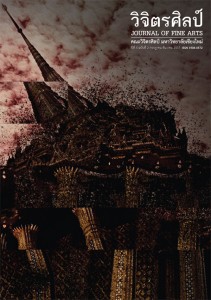การขับขานวรรณกรรมล้านนา : จ๊อย
Main Article Content
Abstract
Joi : Sing a Lanna Traditinal Literature
Joi is a form of a traditional song using lyric from Kao, a form of Lanna traditional literature. Joi have three singing styles called “Labam”; Labam Wing Won, Labam Kong Hiaw Bong, and Labam Ma Yam Fai. This article presents a description of the melodic style of Joi based on the concept of Ethnomusicology and Linguistics. There are three main issues that are presented. 1) Uean, to draw the voice in Thai-style melismatic singing between two words of a song, have three styles; moving pitch uean, long-tone uean, and uean in a word. 2) There are four characteristics of melodic organization of Joi; Tam Nong Lak (main melodic line), Tam Nong Rong (secondary melodic line), Tam Nong Serm (supported melody), and Tam Nong Sum (repeated melody). 3) The creating of Joi melodies related to the intonation of Thai Northern vernacular language by three approaches; parallel motion with tonal marks, contrary motion with tonal marks, and independent deviation from tonal makes.


